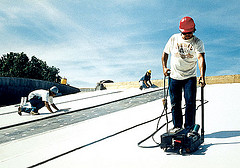
Incorporating green elements into office construction is a simple and eco-conscious way to reduce costs, both for the developer and owner of office properties, as well as potential tenants. While it may be an additional cost upfront, the benefits are numerous and include reduced energy bills for both landlords and tenants, doing right by the environment, and a long-term return on infrastructure. Most importantly, owners that have green- or Energy Star-certified buildings in their portfolio can generate approximately 8.5% higher rents on average.
In 2008, GPX Realty launched a new green initiative to ensure our commercial and multifamily property portfolios are becoming more eco-friendly. This initiative included five green components that drastically reduced energy costs for our properties. Many components of these eco-friendly technology are fairly easy to implement and will dramatically improve a building’s worth.
The first technology that should be utilized to cut costs includes occupancy sensors for lighting, which cut up to 90% of electricity use in an office building. According to the Environmental Protection Agency (EPA), energy savings from occupancy sensors varies from 13% in private offices to 90% in restrooms.
Thermoplastic olefin (TPO) roofing is highly UV- and heat-resistant and can reduce cooling costs by 20%. This roofing is made from polymer blends and can deflect 80% of solar radiation, reducing the amount of the heat that is absorbed through the roof and transferred into the building. Better yet, TPO roofs can be recycled to produce manmade products like manmade slate roofing materials.
To date, GPX Realty Partners has installed over 100,000 square feet of carpeting in all of its properties, so using environmentally-preferable-certified carpeting is especially important in our operations. This carpeting is made of recycled products and uses 25% less yarn than the industry average.
Another component that can drastically reduce energy costs in an office building is energy-efficient HVAC units. Current HVAC systems have a Seasonal Energy Efficiency Ration (SEER), which is a measure of how efficiently a HVAC unit operates over an entire season. Higher SEERs indicate higher efficiency, which lowers cooling costs. Our firm is in the process of replacing all of our SEER units with units that have a 13 or 14 SEER rating, which boosts energy efficiency by 30%.
Low-VOC (Volatile Organic Compounds) interior paints can reduce over 60% of toxic emissions and improve overall air quality. According the EPA, paints and finishes are one of the leading causes of indoor air pollutants and a hazard to human health.
Finally, developers can recycle construction debris that is used in tenant fit-outs and project developments to reduce landfill contributions. Most materials used in construction can be recycled and include concrete, asphalt, brick, cardboard, wood, plate glass, drywall, which a multitude of metals, which also include plumbing fixtures, fasteners, and metal studs, to name just a few materials.
These minor changes in the way we build new offices have had drastic effects and commercial property owners and developers that implement these minor changes will immediately start to reap the benefits.
Christopher Canale is Vice President of Operations for Philadelphia-based GPX Realty Partners, L.P. Canale brings more than 17 years of hands-on experience in operations, construction, and real estate facilities management to his role as Vice President of Operations for GPX Realty Partners, LP. In this capacity, Canale’s primary responsibilities are to oversee the property management operations, construction, and facilities for GPX Realty Partners, L.P. For more information, please visit www.gpxrealty.com.

